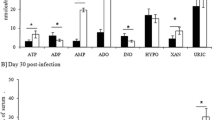Abstract
We studied the cellular and humoral events which follow experimental acute pyelonephritis from P-fimbriated Escherichia coli to gain insight into the relationships among cells and specifically cytokines to determine how early events in untreated infection lead to renal damage. Cynomolgus (Macaca fascicularis) monkeys were studied after they were subjected to unilateral ureteral bacterial inoculation. We evaluated the blood for leukocytosis and studied lymphocyte subsets using flow cytometry and monoclonal antibodies to the subsets and serum, complement, cytokines and antibody titers. Interleukin-1, 2, and 6 and tumor necrosis factor (TNF) were assayed by enzyme-linked immunoadsorbent assay (ELISA), using monoclonal and polyclonal antibodies. Leukocytosis was marked and there were significant elevations in serum cytokines, interleukin-1α, 2 and 6 with only small changes in the level of TNF. Interleukin-2 levels were sustained and may have upregulated the homing receptor for virgin lymphocytes. The studies illustrated the unique relationship between cytokines and lymphocytes and the response to bacterial infection, showing that the inflammatory response is regulated not only by cytokine activity but also by lymphocyte activation.
Similar content being viewed by others
References
Agace W, Hedges S, Andersson U, Andersson J, Ceska M, Svanborg C (1993) Selective cytokine production by epithelial cells following exposure to Escherichia coli. Infect Immun 61: 602
Arnaout MA (1993) Cell adhesion molecules in inflammation and thrombosis: status and prospects. Am J Kidney Dis 21: 72
Billiau A, Vandekerckhove F (1991) Cytokines and their interactions with other inflammatory mediators in the pathogenesis of sepsis and septic shock. Eur J Clin Invest 21: 55
Camerini D, James SP, Stamenkovic I, Seed B (1989) Leu8/TQ1 is the human equivalent of the Mel-14 lymph node homing receptor. Nature 342: 78
Couturier C, Jahns G, Kazatchkine MD, Haeffner-Cavaillon N (1992) Membrane molecules which trigger the production of interleukin-1 and tumor necrosis factor-α by lipopolysaccharide-stimulated human monocytes. Eur J Immunol 22: 1461
Daimle NK, Doyle LV (1980) Ability of human T lymphocytes to adhere to nascular endothelial cells and to augment endothelial permeability to macromolecules is linked to their state of post-thymic maturation. J Immunol 144: 1233
Ellner JJ, Spagnuolo PJ (1979) Suppression of antigen and mitogen induced human T lymphocyte DNA synthesis by bacterial lipopolysaccharide: mediation by monocyte activation and production of prostaglandins. J Immunol 123: 2689
Gatenby PA, Kansas GS, Xian CY, Evans RL, Engleman EG (1982) Dissection of immunoregulatory subpopulations of T lymphocytes within the helper and suppressor lineages in man. J Immunol 129: 1997
Hedges S, Anderson P, Lidin-Janson G, Svanborg C (1991) Interleukin-6 response to deliberate gram-negative colonization of the human urinary tract. Infect Immun 59: 421
Lotz MT, Matory YL, Ettinghausen SE, Rayner AA, Sharrow SO, Seipp CA, Custer MC, Rosenberg SA (1985) In vivo administration of purified human interleukin-2. II. Half-life, immunologic effects and expansion of peripheral lymphoid cells in vivo with recombinant IL-2. J Immunol 135: 2865
Mackay CR, Marston WL, Dudler L (1990) Naive and memory T cells show distinct pathways of lymphocyte recirculation. J Exp Med 171: 801
Miller T, North D (1979) Immunobiologic factors in the pathogenesis of renal infection. Kidney Int 16: 665
Morimoto C, Letvin NL, Boyd AW, Hagan M, Brown HM, Kornacki MM, Schlossman SF (1985) The isolation and characterization of the human helper inducer T cell subset. J Immunol 134: 3762
Morimoto C, Letvin NL, Distaso JA, Aldrich WR, Schlossman SF (1985) The isolation and characterization of the human suppressor inducer T cell subset. J Immunol 134: 1508
Murray HW (1990) Gamma interferon, cytokine-induced macrophage activation, and antimicrobial host defense. In vitro in animal models, and in humans. Diagn Microbiol Infect Dis 13: 411
Powrie F, Coffman RL (1993) Cytokine regulation of T-cell function: potential for therapeutic intervention. Immunol Today 14: 270
Roberts JA (1991) Etiology and pathophysiology of pyelonephritis, Am J Kidney Dis 17: 1
Roberts JA, Domingue GJ, Martin LN, Kim JCS (1981) Immunology of pyelonephritis in the primate model: live versus heatkilled bacteria. Kidney Int 19: 297
Roberts JA, Kaack MB, Baskin G (1990) Treatment of experimental pyelonephritis in the monkey. J Urol 143: 150
Roberts JA, Kaack MB, Fussell EF, Baskin G (1986) Immunology of pyelonephritis. VII. Effect of allopurinol. J Urol 136: 960
Roberts JA, Kaack B, Kallenius G, Mollby R, Winberg J, Svenson SB (1984) Receptors for pyelonephritogenic Escherichia coli in primates. J Urol 131: 163
Roberts JA, Roth JK Jr, Domingue G, Lewis RW, Kaack B, Baskin GB (1982) Immunology of pyelonephritis in the primate model. V. Effect of superoxide dismutase. J Urol 129: 1394
Roberts JA, Roth JK Jr, Domingue G, Lewis RW, Kaack B, Baskin GB (1983) Immunology of pyelonephritis in the primate model. VI. Effect of complement depletion. J Urol 129
Sanders ME, Makgoba MW, Sharrow SO, Stephany D, Spriunger TA, Young HA, Shaw S (1988) Human memory T lymphocytes express increased levels of three cell adhesion molecules (LFA-3, CD2, and LFA-1) and three other molecules (UCHL-1, CDw29, and Pgp-1) and have enhanced IFN g production. J Immunol 140: 1401
Smith JW (1980) Role of suppressor cells in experimental pyelonephritis. J Infect Dis 143: 199
Van Snick J (1990) Interleukin-6: an overview. Ann Rev Immunol 8: 253
Author information
Authors and Affiliations
Rights and permissions
About this article
Cite this article
Roberts, J.A., Kaack, M.B. & Martin, L.N. Cytokine and lymphocyte activation during experimental acute pyelonephritis. Urol. Res. 23, 33–38 (1995). https://doi.org/10.1007/BF00298848
Received:
Accepted:
Issue Date:
DOI: https://doi.org/10.1007/BF00298848




